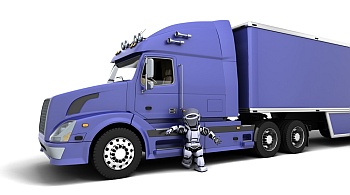ATA’s Technology and Maintenance Council takes a look at future trucks
The Technology and Maintenance Council (TMC) of the American Trucking Associations’ Future Truck program has been looking at the future of trucking for three decades now and its latest survey of trucking industry officials offers up the following predictions:
1. Better fuel economy
More than half the fleets in TMC’s survey think we’ll see trucks achieving better than 9 mpg – a feat already being achieved by some fleets. Peterbilt Chief Engineer Landon Sproull says its first-generation SuperTruck concept tractor-trailer achieved nearly 10 mpg.
Fuel economy is being driven both by fleet demand and by federal regulations to reduce greenhouse gas emissions (GHG). There already is, and will continue to be, an increasing focus on the power train as a whole, with the transmission, engine and axles all working together for the optimal fuel economy.
2.‘Right-sized’ vehicles and engines
Fleets are realizing that they may be able to save fuel and upfront purchase costs by using a smaller or less powerful vehicle that more closely fits their needs, and that trend is likely to continue.
Todd Bloom, president and CEO of Mitsubishi Fuso Truck of America, describes this as a “trend to use the right vehicle for the right job.”
“Instead of getting more truck than you need so you’ll never be overloaded, it makes more sense to get that loaded 90 percent every day,” he says. “If you need more for the busy season, you can go out and rent what you need.”
3. Better durability and maintenance
By 2025, TMC fleet members say, we’ll see trucks that are more reliable.
- Oil change intervals may continue to increase, with TMC’s survey predicting oil change intervals of more than 60,000 miles.
- More fleets will go to air disc brakes, which take less maintenance than traditional drum brakes, with half saying it would be over 75 percent.
- TMC members predict 80 percent or greater usage of tire pressure monitoring and inflation systems, and a likely addition of tread depth sensors, to help tires last longer and save fuel.
- We will continue to see improvements in the electrical and battery area. Ultra capacitors are on the horizon, says TMC, and a switch to 24 volts is probable.
Computer technology, from electronic driver vehicle inspections to telematics, may play the largest role in improved vehicle uptime. Truck makers are now offering telematics systems that communicate between the truck, the dealer/OE and the back office about any problems happening on the vehicle.
4. Alternative fuels
Beyond the next couple of years, we’re seeing a groundswell for alternative fuels, especially natural gas. More investment is being made in engine platforms to expand that portfolio, and that competition drives further advancements on the technology standpoint and also drives cost out of the offering.
Don’t count out other alternative fuels, such as advanced biofuels made from algae and other non-food stocks. Volvo and Mack believe DME, or dimethyl ether, is the fuel of the future. Hybrid, electric, propane, natural-gas-to-liquid, all will likely play a role in powering future trucks.
5. Changes in the cab
Expect more integration of in-cab technology into the OE dashboard. Both Freightliner and Peterbilt have showed concept trucks featuring a removable tablet in the dash that can display virtual gauges, navigation and instantaneous feedback on fuel economy and unsafe driving. The tablet can be removed when the truck is not in motion to perform electronic vehicle inspections or for the driver to use to connect with family members or other personal use.
Sleepers may get smaller as more fleets move to regional haul or hub and spoke type operations.
6. More safety features
We’ll almost certainly see more penetration of high-tech safety systems such as collision avoidance, lane departure warning, rollover prevention and stability control. TMC’s survey predicts greater than 80 percent usage of lane departure warning systems and collision warning/mitigation systems. They believe we’ll see more than 60 percent usage of blind spot monitors, and more than 40 percent usage of cameras monitoring the driver.
7. Connected vehicles and highways
TMC members believe vehicle-to-infrastructure communications are likely. Wireless communications between the tractor and trailer are seen as likely in the survey, and vehicle-to-vehicle communications are seen as probable.
While autonomous vehicles are a long way out, the technology is there. Demonstration vehicles today are showing that’s very feasible.
Even with the advances in technology, the experts predict we will still need drivers for the foreseeable future.






